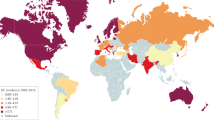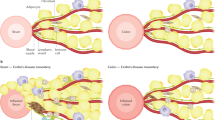Abstract
Evidence is accumulating that both genetic and environmental factors contribute to ulcerative colitis. The most consistent genetic associations have been shown for the MHC locus HLA Class II alleles, but the interleukin-1 family of genes and the multidrug resistance gene MDR1 have also been implicated as genetic susceptibility factors for the development of disease. In addition, there is a relationship between ulcerative colitis and bacterial flora, with an increased number of adherent Bacteroides spp. and Enterobacteriaceae spp. present in inflamed bowel segments. Conversely, cigarette smoking and appendectomy have both been shown to protect against the development of ulcerative colitis. Despite our improved understanding of the genetics and inflammatory mechanisms that underpin this disease, however, the etiology and pathogenesis of ulcerative colitis remain undefined. The diagnosis of ulcerative colitis is being aided by recent advances in diagnostic strategies, including the detection of fecal and serologic markers and the use of wireless capsule endoscopy, but, in the absence of a pathognomonic marker, the definition of this disease remains based on well-established clinical, endoscopic and histologic criteria. In particular, it is difficult to discriminate ulcerative colitis from other forms of colitis, including Crohn's disease, and there seems to be a growing overlap of pathophysiologic processes between ulcerative colitis and post-infectious irritable bowel syndrome. Patients who remain indeterminate between ulcerative colitis and Crohn's disease also continue to be a diagnostic challenge.
This is a preview of subscription content, access via your institution
Access options
Subscribe to this journal
Receive 12 print issues and online access
$209.00 per year
only $17.42 per issue
Buy this article
- Purchase on Springer Link
- Instant access to full article PDF
Prices may be subject to local taxes which are calculated during checkout
Similar content being viewed by others
References
Bonen DK and Cho JH (2003) The genetics of inflammatory bowel disease. Gastroenterology 124: 521–536
Ahmad T et al. (2003) Genotype-based phenotyping heralds a new taxonomy for inflammatory bowel disease. Curr Opin Gastroenterol 19: 327–335
Satsangi J et al. (2003) Genetics of inflammatory bowel disease: scientific and clinical implications. Best Pract Res Clin Gastroenterol 17: 3–18
Halfvarson J et al. (2003) Inflammatory bowel disease in a Swedish twin cohort: a long-term follow-up of concordance and clinical characteristics. Gastroenterology 124: 1767–1773
Pallone F et al. (2003) Genetic and pathogenetic insights into inflammatory bowel disease. Curr Gastroenterol Rep 5: 487–492
Silverberg MS et al. (2003) A population- and family-based study of Canadian families reveals association of HLA DRB1*0103 with colonic involvement in inflammatory bowel disease. Inflamm Bowel Dis 9: 1–9
Schwab M et al. (2003) Association between the C3435T MDR1 gene polymorphism and susceptibility for ulcerative colitis. Gastroenterology 124: 26–33
Orchard T (2003) Extraintestinal complications of inflammatory bowel disease. Curr Gastroenterol Rep 5: 512–517
Orchard TR et al. (2002. Uveitis and erythema nodosum in inflammatory bowel disease: clinical features and the role of HLA genes. Gastroenterology 123: 714–718
Mitchell SA et al. (2002) Cigarette smoking, appendectomy, and tonsillectomy as risk factors for the development of primary sclerosing cholangitis: a case control study. Gut 51: 567–573
Krishnan A and Korzenik JR (2002) Inflammatory bowel disease and environmental influences. Gastroenterol Clin North Am 31: 21–39
Bridger S et al. (2002). In siblings with similar genetic susceptibility for inflammatory bowel disease, smokers tend to develop Crohn's disease and non-smokers develop ulcerative colitis. Gut 51: 21–25
Abraham N et al. (2003) Is smoking an indirect risk factor for the development of ulcerative colitis? An age- and sex-matched case-control study. J Gastroenterol Hepatol 18: 139–146
Mitchell SA et al. (2002) Cigarette smoking, appendectomy, and tonsillectomy as risk factors for the development of primary sclerosing cholangitis: a case control study. Gut 51: 567–573
Radford-Smith GL et al. (2002) Protective role of appendicectomy on onset and severity of ulcerative colitis and Crohn's disease. Gut 51: 808–813
Cosnes J et al. (2002) Effects of appendicectomy on the course of ulcerative colitis. Gut 51: 803–807
Halme L et al. (2002) Familial and sporadic inflammatory bowel disease: comparison of clinical features and serological markers in a genetically homogeneous population. Scand J Gastroenterol 37: 692–698
Feeney MA et al. (2002) A case-control study of childhood environmental risk factors for the development of inflammatory bowel disease. Eur J Gastroenterol Hepatol 14: 529–534
Kurina LM et al. (2002) Appendicectomy, tonsillectomy, and inflammatory bowel disease: a case-control record linkage study. J Epidemiol Community Health 56: 551–554
Caserta L, et al. (2002) Relationship between anamnestic evidence of appendectomy and onset and clinical course of Crohn's disease. Am J Gastroenterol 97: 207–208
Sartor RB (2004) Microbial influences in inflammatory bowel disease: role in pathogenesis and clinical implications. In Kirsner's Inflammatory Bowel Diseases, 138–162 (Eds Sartor RB and Sandborn WJ) Philadelphia: WB Saunders
Cong Y et al. (2002) Bacterial-reactive T regulatory cells inhibit pathogenic immune responses to the enteric flora. J Immunol 169: 6112–6119
Swidsinski A et al. (2002) Mucosal flora in inflammatory bowel disease. Gastroenterology 122: 44–54
Weiss ST . (2002) Eat dirt—the hygiene hypothesis and allergic diseases. N Engl J Med 347: 930–931
Yazdanbakhsh M et al. (2002) Allergy, parasites, and the hygiene hypothesis. Science 296: 490–494
Weinstock JV et al. (2002) The possible link between de-worming and the emergence of immunological disease. J Lab Clin Med 139: 334–338
Weinstock JV et al. (2004) Helminths and harmony. Gut 53: 7–9
Summers RW et al. (2003) Trichuris suis seems to be safe and possibly effective in the treatment of inflammatory bowel disease. Am J Gastroenterol 98: 2034–2041
Landers CJ et al. (2002) Selected loss of tolerance evidenced by Crohn's disease-associated immune responses to auto- and microbial antigens. Gastroenterology 123: 689–699
Heller F et al. (2002) Oxazolone colitis, a Th2 colitis model resembling ulcerative colitis, is mediated by IL-13-producing NK-T cells. Immunity 17: 629–638
Podolsky DK . (2002) Inflammatory bowel disease. N Engl J Med 347: 417–429
Bradesi S et al. (2003) Inflammatory bowel disease and irritable bowel syndrome: separate or unified? Curr Opin Gastroenterol 19: 336–342
Delgado-Aros S and Cremonini F (2003) Role of fecal calprotectin test in the work-up of IBS patients. Gastroenterology 124: 1164–1165
Aadland E and Fagerhol MK (2002) Faecal calprotectin: a marker of inflammation throughout the intestinal tract. Eur J Gastroenterol Hepatol 14: 823–825
Summerton CB et al. (2002) Faecal calprotectin: a marker of inflammation throughout the intestinal tract. Eur J Gastroenterol Hepatol 14: 841–845
Kane SV et al. (2003) Fecal lactoferrin is a sensitive and specific marker in identifying intestinal inflammation. Am J Gastroenterol 98: 1309–1314
Vasiliauskas E (2003) Recent advances in the diagnosis and classification of inflammatory bowel disease. Curr Gastroenterol Rep 5: 493–500
Heller F and Duchmann R (2003) Intestinal flora and mucosal immune responses. Int J Med Microbiol 293: 77–86
Dubinsky MC et al. (2002) Suspected inflammatory bowel disease—the clinical and economic impact of competing diagnostic strategies. Am J Gastroenterol 97: 2333–2342
Joossens S et al. (2002) The value of serologic markers in indeterminate colitis: a prospective follow-up study. Gastroenterology 122: 1242–1247
Fireman Z, et al. (2003) Diagnosing small bowel Crohn's disease with wireless capsule endoscopy. Gut 52: 390–392
Costamagna G et al. (2002) A prospective trial comparing small bowel radiographs and video capsule endoscopy for suspected small bowel disease. Gastroenterology 123: 999–1005
Schulmann K et al. (2003) Diagnosing small bowel Crohn's disease with wireless capsule endoscopy. Gut 52: 1531–1532
Liangpunsakul S et al. (2003) Wireless capsule endoscopy detects small bowel ulcers in patients with normal results from state of the art enteroclysis. Am J Gastroenterol 98: 1295–1298
Schreyer AG et al. (2003) New diagnostic avenues in inflammatory bowel diseases. Capsule endoscopy, magnetic resonance imaging and virtual enteroscopy. Dig Dis 21: 129–137
Bardan E et al. (2003) Capsule endoscopy for the evaluation of patients with chronic abdominal pain. Endoscopy 35: 688–689
Author information
Authors and Affiliations
Corresponding author
Ethics declarations
Competing interests
The author declares that he has received clinical research support from Abbott Labs, Ashahi, Celltech, Centocor, Elan, Genentech, Otsuka, Procter & Gamble, Protein Design Labs and Prometheus Laboratories. He has acted as a consultant for Abbott Labs, Ashahi, Celltech, Centocor, Elan, Genentech, Otsuka, Procter & Gamble, Protein Design Labs and Shire. He is a speaker for Centocor and Procter & Gamble.
Glossary
- ANKYLOSING SPONDYLITIS
-
A degenerative inflammatory disease affecting the joints of the spine: calcification, ossification and ankylosis can cause rigidity of the spine
- SACROILIITIS
-
Inflammation in the sacroiliac joint
- ERYTHEMA NODOSUM
-
Red bruise-like patches caused by panniculitis that normally results from hypersensitivity (e.g. to drugs or enteropathies), but can be idiopathic
- UVEITIS
-
Inflammation of part or all of the vascular tunic of the eye (the uvea). The sclera, cornea and retina may also be involved
- DEXTRAN SULFATE
-
A long-chain glucose polymer that contains sulfur. It is used to induce colitis in mouse models of inflammatory bowel disease
- DYSBIOSIS
-
An imbalance of the intestinal microbial flora that is thought to promote disease. It can be caused by parasites, fungal overgrowth, bacteria and poor diet
- WIRELESS CAPSULE ENDOSCOPY
-
Endoscopy performed using a disposable capsule that is self-illuminating and contains a camera that can transmit images via wireless radiotransmission to an external recording device
Rights and permissions
About this article
Cite this article
Hanauer, S. Update on the etiology, pathogenesis and diagnosis of ulcerative colitis. Nat Rev Gastroenterol Hepatol 1, 26–31 (2004). https://doi.org/10.1038/ncpgasthep0031
Issue Date:
DOI: https://doi.org/10.1038/ncpgasthep0031
This article is cited by
-
Effects of a P2X7 receptor antagonist on myenteric neurons in the distal colon of an experimental rat model of ulcerative colitis
Histochemistry and Cell Biology (2022)
-
Augmenting vascular disease diagnosis by vasculature-aware unsupervised learning
Nature Machine Intelligence (2020)
-
Colonic hypereosinophilia in ulcerative colitis may help to predict the failure of steroid therapy
Techniques in Coloproctology (2018)
-
Dietary supplementation with β-glucan enriched oat bran increases faecal concentration of carboxylic acids in healthy subjects
European Journal of Clinical Nutrition (2008)



